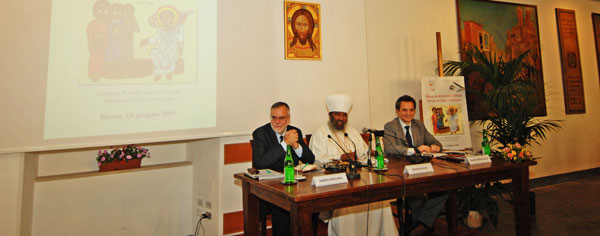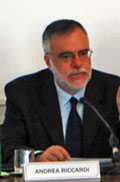18 June 2009
Rome, conference "Ethiopia, an African Christianism"
A day dedicated to the Ethiopian Church, making known the richness and the reality of a branch of christianity which is “alive, not just archaeological, a son of the East and of Africa simultaneously”.

With these words Andrea Riccardi opened the conference on “Ethiopia: an African Christianity”, hosted by the Sant’ Egidio Community on 18th June.
The patriarch of the Ethiopian Orthodox church, Abuna Paulos attended the conference, having also had an audience with the Pope. The patriarch spoke of his appreciation for the initiative of the Community, and emphasised a fifteen year friendship during which he has attended Prayer for Peace meetings that he has personally promoted. This event, the first of its kind held in the Italian capital, has brought together scholars, academics and Ethiopian priests from across Europe with the aim of making a branch of christianity known, understood and loved in Italy and Europe. Ethiopian christianity maintains a particular tradition, acting as a channel between different religions. It has “a special relationship with Jewish tradition and has often been compared to Islam”. The Ethiopian Church has “known cultural and then political colonialism”, but has kept alive its unique identity representing “the only example of African christianity not to have been imported from Europe”.
There have been contributions in the course of the conference from Leonardo Sandri, prefect of the Congregation for the Eastern Churches; from Vincenzo Scotti, Undersecretary to the Ministry of Foreign Affairs; from the nephew of Emperor Haile Selassie, Aklile Berhan Makonnen Haile Selassie as part of the focus on Africa that has included Pope Benedict XVI’s visit to the African continent, the Religious G8 held recently at the Farnesina and the African Synod to be held at the Vatican next October. Abuna Paulos believes that this focus is vital for development and fresh understanding of Ethiopian christianity:
“Ours is a Church of the New Testament. It functions as a living body, not an archaic one” says Abuna Paulos. “It keeps its tradition intact in a unique way. There are 15 thousand parishes and 800 thousand members of the clergy serving 50 million faithful”. Abuna Paulos hopes that “with collaboration and help from courageous people, a greater desire and greater work will become possible, especially for the Ethiopian youngsters who are becoming involved in the Church”.
| An Introduction by Andrea Riccardi |
Ethiopia: An African Christianism
 On behalf of the Sant’ Egidio Community, I am very pleased to be opening this conference: “Ethiopia: An African Christianity”. Firstly, I would like to thank His Holiness Abuna Paulos for his presence, to whom I have personal ties of admiration and friendship. His Holiness represents an important part of history. In his youth he knew the violence of Italian fascist occupation, which struck the Ethiopian state and the Orthodox Tewahido Church.
On behalf of the Sant’ Egidio Community, I am very pleased to be opening this conference: “Ethiopia: An African Christianity”. Firstly, I would like to thank His Holiness Abuna Paulos for his presence, to whom I have personal ties of admiration and friendship. His Holiness represents an important part of history. In his youth he knew the violence of Italian fascist occupation, which struck the Ethiopian state and the Orthodox Tewahido Church.
One must not forget that this Church has seen many twentieth century martyrs, during the fascist occupation above all. I have visited the great monastery of Debra Libanos, at the heart of this monastic Church and its people. Opposite the monastery, a grave remembers the hundreds of monks, choristers, deacons and youngsters who were slaughtered. With harshness, Marshall Graziani carried out the terrible orders received from Mussolini: “Any civilians or religious arousing suspicion must be shot without hesitation”.
Ethiopian Christianity which historically had been the soul of the people and the foundation of national independence, was hit by a painful chapter of martyrdom. It is a chapter which the Sant’Egidio Community wishes to remember by laying down a memorial to the new Ethiopian martyrs in the Basilica of Saint Bartholomew on the Island in Rome, which John Paul II wished to be a place of remembrance for twentieth century martyrs.
Abuna Paulos is a witness to the rebirth of the Church under the guidance of Emperor Haile Selassie (who visited Pope Paul VI in 1970), and of his opening of theological studies, ancient Eastern churches, as well as orthodox and catholic ones. For a Church with such ancient roots, that has built its strength on faithfulness to its traditions, a new dawn opened after the second world war until the middle of the nineteen seventies. Abuna Paulos is a witness to that dawn, represented by his youthfulness, his ecumenical and cultural contacts and the growth of theological culture in tewahido christianity.
His election as bishop coincided with another difficult period for his people and his Church: the Mengitsu dictatorship with its limitless violence against the civilian population and religious, including Abuna Theofios who was imprisoned and martyred. It is a little known fact that Abuna Paulos was imprisoned for many years before going into exile. From there he dedicated himself to the Ethiopian diaspora in the United States.
After the fall of the Derg, bishop Paulos returned to Ethiopia where he was consecrated patriarch in 1992 at the cathedral of the Holy Trinity in Addis Abeba. He reopened the theological college of the Holy Trinity which had been closed by the Derg. Recent years have been a time of reconstruction for a Church which has suffered much, with cultural and pastoral development between an ancient tradition and the reality of the modern world. His Holiness has rebuilt the Ethiopian Church. We have known him since the beginning of his mandate as patriarch. I remember him participating, for the first time, at the inter-religious meeting in the spirit of Assisi, held in Assisi itself in 1994. In 2009, we are celebrating fifteen years of friendship and closeness. So I welcome His Holiness, as a witness to history and the Ethiopian Church; as a witness to suffering and hope, and as a great friend of Sant’Egidio.
We wanted to organise this conference, “Ethiopia: An African Christianity”, because this great branch of christianity must become better known, understood and loved throughout Italy and Europe. I thank all the authoritative speakers giving contributions to this conference. In fact, after the Second Vatican Council, in Italy and the Catholic world, interest in the Eastern Orthodox became rejuvenated. A need to look to the East, as part of a rediscovery of our vital roots has been felt. Africa too, with its more recent christianity, has been looked to, despite huge problems regarding humanity, society and peace. However, few know Ethiopian christianity which is rooted in the christian East, but also has a special relationship with Jewish tradition. Yes, few know this great branch of christianity, its history, its people, and also its spirituality with a tradition of prayer, and I would add, of humanity.
I am not a specialist, but I love Africa. The Sant’Egidio Community is rooted in more than twenty African countries. Ethiopian christianity is a synthesis of ancient christian Eastern tradition and the reality of Africa. In fact, Ethiopia represents the only ‘African’ christianity which has not been imported from Europe, but comes from an ancient tradition with apostolic roots. The Ethiopian Church was established over centuries within eastern christianity, while assuming and maintaining it’s African identity. Ethiopia is the only African country to possess ancient written languages, such as Amharic (the official language) and Ge’ez (the liturgical language). I am convinced that Ethiopian christianity must be better known. From a spiritual standpoint, it has great treasures to communicate to christians across the world.
I want to underline that this conference is taking place in 2009, a special year dedicated to Africa. With the economic crisis, Africa runs the risk of being forgotten. The African continent is not just land from which to draw raw materials, but from a human perspective it is a rich, living reality.
This is particularly true for Ethiopia, where The Organisation for African Unity is based. The patriarch is in Rome for an important “Religious G8 Summit”. For the Catholic Church, Africa is of central importance after the visit by Benedict XVI last March, and for the African synod which will be held in Rome next October. A voyage then, setting out from Rome, passing through Venice-where an exhibition of Ethiopian christian art was recently held-arriving in Addis Abeba, where the XVII International conference on Ethiopian Studies will take place.
This conference will consider the formation of christian Ethiopia, making a comparison between Ethiopian christianity and the modern world. A longstanding historical perspective, tracing the most important events and characters of this “African christianity”, and its role in the formation of the State.
The participation of eminent scholars, both Italian and foreign, is worth noting, with their willingness to tackle complex multifaceted issues, ranging from the formation of the State to spirituality and the role of christianity in a multi ethnic society; from a comparison with modernity to the problem of multi-religious cohabitation and international relations; including the characterisation of a confessional State. So I thank all the participants, and I hope to follow their work which promises to be of great interest.











